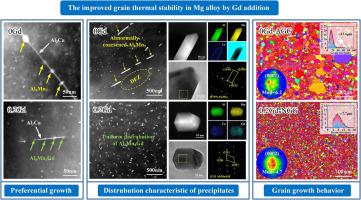微量Gd对稀Mg-Al-Ca-Mn合金异常晶粒生长的抑制机制
IF 13.8
1区 材料科学
Q1 METALLURGY & METALLURGICAL ENGINEERING
引用次数: 0
摘要
异常晶粒生长(AGG)是稀镁合金在高温加工过程中普遍存在的现象,它通过微观组织退化严重影响了合金的力学性能。本研究研究了可热处理Mg-1Al-0.3Ca-0.5Mn (wt.%)合金中AGG的演化过程,通过相相互作用分析揭示了AGG演化的基本机制。AGG的产生主要是由异常粗化的Al₈Mn₅沉淀物周围的齐纳钉钉力衰减驱动的。在机械上,这种非均质粗化源于均匀化处理过程中邻近Al₂Ca相的优先Al₈Mn₅相生长动力学,造成局部钉住力不连续。然而,添加0.2 wt.%的Gd有利于Al₈Mn₅相转变为热稳定的Al₈Mn₄Gd,具有较低的吉布斯自由能,从而促进了更均匀和精炼的沉淀分布。因此,含gd合金表现出增强的晶粒热稳定性,即使在500°C下经过1小时T4处理后,仍保持平均晶粒尺寸为~ 7.7 μ m的精致组织,与不含gd合金相比,同时提高了强度和延展性。本文章由计算机程序翻译,如有差异,请以英文原文为准。

The inhibition mechanism of abnormal grain growth in dilute Mg–Al–Ca–Mn alloy through trace Gd addition
Abnormal grain growth (AGG), a prevalent phenomenon in dilute magnesium (Mg) alloys during elevated-temperature processing, significantly compromises mechanical performance through microstructural degradation. This study investigates AGG evolution in a heat-treatable Mg–1Al–0.3Ca–0.5Mn (wt.%) alloy, revealing its fundamental mechanism through phase interaction analysis. The AGG initiation is predominantly driven by Zener pinning force attenuation around abnormally coarsened Al₈Mn₅ precipitates. Mechanistically, this heterogeneous coarsening stems from preferential Al₈Mn₅ phase growth kinetics adjacent to Al₂Ca phase during homogenization treatment, creating localized pinning force discontinuities. However, addition of 0.2 wt.% Gd facilitates phase transformation from Al₈Mn₅ to thermally stable Al₈Mn₄Gd with lower Gibbs free energy, thereby promoting a more uniform and refined precipitate distribution. Consequently, the Gd-containing alloy exhibits enhanced grain thermal stability, maintaining a refined microstructure with average grain size of ∼7.7 µm even after T4 treatment at 500 °C for 1 h, which simultaneously improves strength and ductility compared to the Gd-free alloy.
求助全文
通过发布文献求助,成功后即可免费获取论文全文。
去求助
来源期刊

Journal of Magnesium and Alloys
Engineering-Mechanics of Materials
CiteScore
20.20
自引率
14.80%
发文量
52
审稿时长
59 days
期刊介绍:
The Journal of Magnesium and Alloys serves as a global platform for both theoretical and experimental studies in magnesium science and engineering. It welcomes submissions investigating various scientific and engineering factors impacting the metallurgy, processing, microstructure, properties, and applications of magnesium and alloys. The journal covers all aspects of magnesium and alloy research, including raw materials, alloy casting, extrusion and deformation, corrosion and surface treatment, joining and machining, simulation and modeling, microstructure evolution and mechanical properties, new alloy development, magnesium-based composites, bio-materials and energy materials, applications, and recycling.
 求助内容:
求助内容: 应助结果提醒方式:
应助结果提醒方式:


